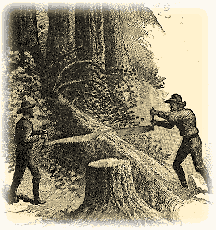Michigan History Themes, Examples, Definition and Description - Beginnings to Present
What Do They Mean? That's what the following paragraphs will explain.
Theme 1: The movement of people, the spread and interaction of cultures and technological innovations continue to shape Michigan. (Civilization, Cultural Diffusion, and Innovation)
 A major theme in history is civilization, cultural diffusion and innovation; these concepts deal with the spread of tools, machines, traditions, lifestyles, laws, practices and ideas. To understand history we need to look at how groups of people have interacted, their goals, tools and inventions. Teachers of social studies must help students recognize the fluid interplay between different groups and the struggle to maintain a group identity while absorbing and accommodating change. Often once an idea has been unleashed it cannot be contained and frequently causes an unanticipated transformation---the process of diffusion.
A major theme in history is civilization, cultural diffusion and innovation; these concepts deal with the spread of tools, machines, traditions, lifestyles, laws, practices and ideas. To understand history we need to look at how groups of people have interacted, their goals, tools and inventions. Teachers of social studies must help students recognize the fluid interplay between different groups and the struggle to maintain a group identity while absorbing and accommodating change. Often once an idea has been unleashed it cannot be contained and frequently causes an unanticipated transformation---the process of diffusion.
Human groups continually influence each others lifestyles, whether by intention or not. For example, Europeans used technology to explore and trade. Their actions and values dominated Native Americans, forever changing the lifestyle of native peoples. A prohibition against reading and writing by enslaved Africans was once used to dominate African Americans, yet it has become an important means of expression of African American culture. Political rights, originally reserved only for white male property owners, once unleashed, could not be denied to women and minorities.
The spread and use of ideas and inventions among people causes them to change and evolve. The Internet allows for an unprecedented simultaneous worldwide exchange of ideas. Informal, instantaneous global conversation has implications far beyond what traditional institutions such as government and schools have been established to manage. So they too are changing, transformed by innovation.
Benchmark Alignment: I.2LE.1, I.2LE3, I.3LE3, II.1LE2, II.2LE4, II.3LE3, II.3LE4, II.5LE1, III.5LE2, IV.4LE3
Theme 2: The geography and natural resources of Michigan greatly influence the development of the state. (Human Interaction with the Environment)
Humans influence each other, just as they interact with the natural environment. Events in history need to be seen in light of the struggles of humans to master nature by developing ways to use and control the environment.
Michigan's lumber industry drew thousands of people each year to both work in the forests and to stake out land to start a farm.. The depletion of mature forests in the east and the high demand for lumber in eastern cities as well as Europe, drove the logging out process. Within less than 50 years Michigan's prime evil forests were gone. The vistas of cut-over lands made the once spectacular landscape look like a war zone and changed some of the ecosystems and animal habitats forever.
Benchmark Alignment: I.1LE2, I.2LE1, I.3LE1, I.4LE2, II.2LE3, II.2LE4, II.3LE1, II.3LE3, II.3LE4, II.4LE3, II.4LE5, IV.1LE1, IV.2LE1, IV.2LE3, IV.4LE3, IV.5LE3
Theme 3: Values and new ideas have influenced change and continue to challenge the people of Michigan. (Values, Beliefs, Economics, Political Ideas and Institutions)
 How people organize themselves into political, religious, social, and economic groups is important to an understanding of history and modern life. An accurate understanding of why events occurred as they did is dependent on knowledge of the beliefs that were reflected in the institutions of the time. The relationships between the choices people make about how social structures allot the use of, and access to, resources leads to an understanding of how beliefs and values become institutions over time. Often ideas begin as commonly held assumptions that assume a pattern and become an institution: a social structure that supports the values and beliefs of the dominant culture as they evolve.
How people organize themselves into political, religious, social, and economic groups is important to an understanding of history and modern life. An accurate understanding of why events occurred as they did is dependent on knowledge of the beliefs that were reflected in the institutions of the time. The relationships between the choices people make about how social structures allot the use of, and access to, resources leads to an understanding of how beliefs and values become institutions over time. Often ideas begin as commonly held assumptions that assume a pattern and become an institution: a social structure that supports the values and beliefs of the dominant culture as they evolve.
Labor unions provide a window into how human beliefs; political ideas and distribution of resources develop into an institution. In the early 19th century prevailing legal and social opinions and economic structures did not favor the development of unskilled workers organizations. Wages and the length of the workday were arranged directly in dealings between employers and individual workers. The disparity in power often led to abuse. The beliefs and values of trade unionists began to show in an organized way when they grouped together to form organizations. Eight-hour workdays and health and safety protection for workers were important rallying points. Gradually the beliefs of organized labor became assumptions about the rights of workers embraced by society. As a result, legislation protecting the right to organize and the right of unions to enter into collective bargaining agreements with employers followed. Today Americans accept the role of organized labor in many American businesses and governmental organizations. To achieve lasting learning, teachers of social studies need to help students identify the relationship between historical events and changing beliefs. Accepted beliefs often become assumptions that can evolve into institutions that support those beliefs.
Benchmark Alignment: III.1LE1, IV.3LE3, VI.2LE1
Theme 4: Michigan has been and continues to be shaped by conflicts resolved through cooperation and compromise. (Conflict and Cooperation)
Teachers of Social Studies provide students with a framework for understanding when they teach them that certain patterns of human behavior reoccur. Understanding how some behavior patterns repeat across time and space helps learners to make lasting connections. Much of American history can be meaningfully understood by viewing it in terms of cooperation and conflict. A complete look at American development must include ways people work together and cooperate during times of conflict as well as during times of peace. Furthermore, how we teach about conflict and cooperation affects our students responses to these events in their own lives. Conflicts in Michigan history include resolution of some while others remain unresolved.
Students can learn to identify reoccurring patterns through key events in Michigan history. Even in times of great cooperation, there can also be great conflict. Students will, for example, identify and describe cooperative efforts during colonial times as a key to the survival of colonists. Yet at the same time, controversy and conflict over religion and religious practices were also a part of colonial life. The social studies teacher brings the interplay between conflict and cooperation to light.
During World War II the cooperative efforts of women supported Americas industrial military needs. Social studies teachers insightfully forge a deeper understanding of this era of international conflict when they also characterize it as an era of national cooperation. The ordinary concerns and social and economic inequalities experienced by many Americans continued to exist during this era of national cooperation and dedication to winning the war. It is from the teacher of social studies that the student will gain insight into our nation in which the ordinary, whether an element of conflict or cooperation, continues to exist side by side with the extraordinary. Students experience these same elements of conflict and cooperation in their own lives and social studies educators give students a powerful tool for lasting understanding by teaching learners how to see that these human patterns happen over and over and so connect history to the present.
Benchmark Alignment: I.3LE2, I.4LE1, I.4LE2, III.2LE2, VI.1LE2, VI.1LE3
Theme 5: The historical significance of Michigans growth can be understood by comparing events in the state to regional, national, and world developments. (Comparative History of Major Developments)
We can use comparison and contrast as important teaching vehicles to see historical elements that are separated by space, time, gender or other variables. Looking at differences and similarities help us clarify our understanding of people, times, and places. It can also help us gauge the importance of the topics being studied. Helping our students draw these relationships can provide an opportunity to make them more humane and avoid mistakes from the past. These comparisons can be pathways to insights into our times and ourselves.
Students can deepen their own understanding of human development by looking at, for example, the events that led to abolition and the events that led to universal suffrage and how Michigan citizens promoted those compared to the rest of the United States. Students gain much greater depth of understanding about each group and the times in which they emerged when considered together. A comparative study of Native Peoples on the eve colonization, and the first European settlers show connections and relationships to regions, cultures and legacies that would not necessarily surface if studied without conscious attention to their similarities and differences.
Benchmark Alignment: I.2LE2, I.4LE1, II.1LE1, II.1LE3, 11.3LE2, II.4LE2
Theme 6: The experiences of common people create an understanding of social change connected to immigration, migration, and the industrialization of Michigan. (Patterns of Social and Political Interaction)
The teaching of history needs to include an understanding of the common people as well as the famous. History is incomplete without the daily culture of everyday people. Social history accesses the daily experiences of the men and women who lived during the time being studied. These men and women have left the record of their lives in their labor, poetry, stories, dances, songs, letters, and a myriad of other informal sources. When teachers of social studies put learners into the social context of the time, students meet ordinary people on their terms in their own times and see them as important contributors to key events. This provides students with multiple points of view and gives them a vehicle to engage in critical questioning of historical sources such as: Whose voice am I hearing and why? What might a factory worker, a woman, an African American have thought about this issue?"
We can teach students about these patterns of social and political interactions from many points of view. Primary source documentation includes such items as personal journal entries, photographs, and folk songs. By using these social elements as well as the more traditional sources of governmental records, laws, and textbooks, we allow the learner to have a fuller picture of lives of the people of the time. Students are better able to appreciate the hardships, efforts and contributions of common men and women to the larger events in history. The journalists of the Industrial Age gave a voice to working men, women and children. Songs of workers on the Erie Canal open a window to factors influencing Michigans statehood.
Benchmark Alignment: I.2LE3, I.2LE4, I.4LE1, I.4LE2, VI.1LE2, VI.2LE1



